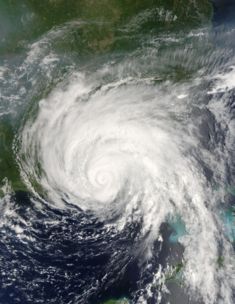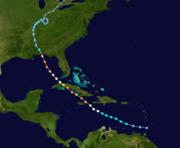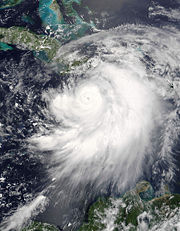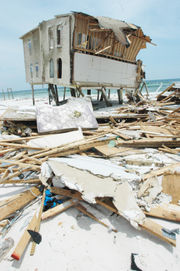Hurricane Dennis
2008/9 Schools Wikipedia Selection. Related subjects: Storms
| Category 4 hurricane ( SSHS) | ||
|---|---|---|
|
Hurricane Dennis on July 10, 2005 at 1615 UTC |
||
| Formed | July 4, 2005 | |
| Dissipated | July 13, 2005 | |
| Highest winds |
|
|
| Lowest pressure | 930 mbar ( hPa; 27.47 inHg) | |
| Fatalities | 42 direct, 47 indirect | |
| Damage | $4 billion (2005 USD) $4.41 billion (2008 USD) |
|
| Areas affected |
Grenada, Haiti, Jamaica, Cuba, Florida, Alabama, Mississippi, Georgia, Tennessee and Ohio Valley regions | |
| Part of the 2005 Atlantic hurricane season |
||
Hurricane Dennis was an early-forming major hurricane in the Caribbean and Gulf of Mexico during the 2005 Atlantic hurricane season. Dennis was the fourth named storm, second hurricane, and first major hurricane of the season. In July, the hurricane set several records for early season hurricane activity, becoming both the earliest formation of a fourth tropical cyclone and the strongest Atlantic hurricane ever to form before August until it was surpassed by Hurricane Emily merely two weeks later.
Dennis hit Cuba twice as a Category 4 hurricane on the Saffir-Simpson Hurricane Scale, and made landfall on the Florida Panhandle in the United States as a Category 3 storm less than a year after Hurricane Ivan did so. Dennis caused at least 89 deaths (42 direct) in the U.S. and Caribbean and caused $2.23 billion (2005 US dollars) in damages to the United States, as well as an approximately equal amount of damage in the Caribbean, primarily on Cuba.
Storm history
Hurricane Dennis began as Tropical Depression Four in the southeastern Caribbean Sea on the evening of July 4, the first storm of the season to form away from Mexico and Central America. Almost immediately, it made landfall on Grenada as a tropical depression with 30 mph (48 km/h) winds. On the morning of July 5, it strengthened into Tropical Storm Dennis in the eastern Caribbean; this was the earliest formation of an Atlantic season's fourth storm (by comparison, during the 2004 season, Hurricane Alex formed in early August and Hurricane Charley made landfall in Cuba on August 12). The newly named Dennis began moving rapidly to the west-northwest.
It was clear from early weather forecasting models that Dennis had the potential to be a major storm, and it was predicted to reach hurricane status while still a tropical depression. It reached hurricane strength on the afternoon of July 6 while approaching the southern coast of Hispaniola, and it quickly became a strong and well-organized Category 1 storm on the Saffir-Simpson Hurricane Scale. The next day it strengthened rapidly to become a Category 4 major hurricane, the earliest in an Atlantic hurricane season that a storm had reached that strength since Hurricane Audrey in the 1957 season. After rapid strengthening, Dennis's track became slightly more northerly, bringing it between Jamaica and Haiti by July 7; both countries experienced high winds and heavy rain. As it approached Cuba and strengthened to just under Category 5 intensity, Dennis's track began to wobble. Meteorologists from the National Hurricane Centre (NHC) stated, "this type of erratic motion is not unusual for intensifying major hurricanes." On July 7, Hurricane warnings were issued for Cuba at 11 a.m. EDT (1500 UTC). Dennis made landfall near Punta dal Inglés with 140 mph (220 km/h) winds late that day, and dropped down to a Category 3 storm while crossing the peninsula. As it moved back into the Gulf of Guacanayabo, its wind speed increased to a peak of 150 mph (240 km/h). Dennis then slammed into south-central Cuba just west of Punta Mangles Altos on July 8, again with 140 mph (220 km/h) winds.
Crossing Cuba's mountainous terrain disrupted the storm's circulation, weakening Dennis to Category 1 intensity. However, NHC forecasts continued to indicate the possibility of a retreat to Category 4 status after convection was re-established. This prediction was borne out when Dennis rapidly reintensified on the afternoon of July 9 over the Gulf Loop Current, a reintensification described by NHC as having occurred "at a rate that bordered on insane." The storm reached Category 4 intensity again on the morning of July 10. At 1200 UTC, the storm reached its peak intensity of 930 mbar (27.47 inHg), surpassing Hurricane Audrey and setting a new record for the strongest storm to form prior to August; the new record stood for less than two weeks before Hurricane Emily surpassed it by reaching a pressure of 929 mbar (27.43 inHg).
The storm continued moving north-northwest towards the central Gulf Coast, which had seen the landfalls of Tropical Storm Arlene in June and Hurricane Cindy the previous week. By the morning of July 10, hurricane warnings were in effect in the U.S. for the Florida Panhandle, Alabama, and Mississippi, with tropical storm warnings extending further east and west along the coast. The NHC predicted a landing at near full strength in the late afternoon. However, much like Hurricane Ivan which struck in the same area the previous year, the storm weakened just before landfall; its maximum sustained winds dropped from 145 mph (235 km/h, Category 4 strength) to 120 mph (195 km/h, Category 3 strength).
Continental landfall occurred at Santa Rosa Island, between Pensacola, Florida, and Navarre Beach, Florida, at 2:25 p.m. CDT (1925 UTC) on July 10. Dennis was a Category 3 hurricane with winds of 115 to 120 mph (185 to 195 km/h). The highest official wind speed reported was a 121 mph (195 km/h) wind gust at Navarre Beach. The storm lost strength over the day and was a tropical depression by early on July 11. The depression persisted, however, and gained a little strength while stalled over Illinois the next day. It finally dissipated in Ontario on July 13, with advisories ceasing a full three days after landfall.
Preparations
Combined with Hurricane Cindy's landfall on the Gulf Coast of the United States, uncertainty over Dennis's final landfall helped push oil prices to a record high of $61.28 a barrel on July 6, and again to $61.50 on July 7, although they dropped below $60 on July 8. Dennis was originally forecast to strike Louisiana, one of the oil-producing regions of the Gulf coast. Speculative spikes in oil prices due to Hurricane Dennis foreshadowed the far greater price spikes caused by Hurricanes Katrina and Rita in late August and September.
In Haiti officials evacuated residents along the coastline, but noted that many were not obliging. In Cuba more than 600,000 residents were moved from their homes to government shelters or other locations in anticipation of Dennis. All schools were closed, and most flights in the country were suspended or cancelled.
In the United States, the governors of Florida, Alabama, Mississippi and Louisiana all declared states of emergency in their states. At 6 a.m. CDT (2300 UTC) on July 9, 2005, all southbound lanes on Interstate 65 from Mobile to Montgomery, Alabama, were closed. Traffic was redirected, making all four lanes northbound to allow evacuations. In Alabama residents in all parts of Mobile County, and those south of I-10 in Baldwin County, were ordered to evacuate. Similar orders were issued in Mississippi for parts of Jackson, Hancock, and Harrison counties; and for coastal areas in the Florida Panhandle stretching from Escambia County to Bay County. Likewise, military installations such as NAS Pensacola, Whiting Field, Eglin AFB, Hurlburt Field and Tyndall AFB were all evacuated days before the storm. Additionally, Red Cross officials opened 87 shelters across the state which were able to hold about 14,000 evacuees.
In Florida, about 50,000 tourists in the Keys were forced to evacuate by July 8. The MacDill Air Force Base in Tampa evacuated its aircraft to McConnell Air Force Base near Wichita. 700,000 people in the Florida panhandle were evacuated in the days prior to Dennis, 100,000 of them in Escambia County alone. As a result of the large evacuations, more than 200 truckloads provided about 1.8 million gallons of gasoline. The Red Cross also moved 60 mobile canteens capable of serving 30,000 hot meals each a day to the staging points of Hattiesburg and Jackson. National guardsmen were mobilized, and four emergency medical teams, each capable of setting up a small field hospital, were on standby. Also, at Eglin Air Force Base, about 20,000 military personnel were evacuated, and at Hurlburt Field, home to Air Force's 16th Special Operations Wing, a mandatory evacuation was ordered for all 15,000 airmen and their families.
Impact
| Deaths from Hurricane Dennis | ||||||
| Country | Total | State | State total |
County | County total |
Direct deaths |
|---|---|---|---|---|---|---|
| Cuba | 16 | 16 | ||||
| Haiti | 56 | 22 | ||||
| Jamaica | 1 | 0 | ||||
| USA | 15 | Florida | 14 | Broward | 3 | 1 |
| Charlotte | 3 | 0 | ||||
| Escambia | 1 | 0 | ||||
| Monroe | 1 | 1 | ||||
| Nassau | 1 | 1 | ||||
| Walton | 1 | 0 | ||||
| Unknown | 4 | 0 | ||||
| Georgia | 1 | DeKalb | 1 | 1 | ||
| Totals | 89 | 42 | ||||
| Because of differing sources, totals may not match. | ||||||
Hurricane Dennis caused $4 – 6 billion (2005 US dollars) and at least 89 deaths in its path past Haiti, Jamaica, Cuba, and the United States.
Caribbean
Dennis first affected Jamaica while still a weak storm. One person was killed there and damage was estimated at $32 million USD.
In Haiti, the Pan American Health Organization reports that 56 deaths and 36 injuries occurred; the storm also destroyed 929 homes and damaged another 3,000, leaving 1,500 families homeless. Among the dead were 16 who were killed when a bridge collapsed during the hurricane. Furthermore, 24 persons are still listed as missing.
From there the storm moved to Cuba, leaving 16 people dead and $1.4 billion in damages as it roared through the island, flattening houses and downing trees and power lines. Heavy rainfall fell across the country, with amounts reaching up to 1092 mm/42.99 inches, making Dennis the wettest storm for the island since Hurricane Flora of 1963. According to reports from the Cuban government, 120,000 homes were damaged, 15,000 of which were destroyed. The citrus and vegetable industries were also devastated as Cuba's primary agricultural regions were the hardest hit. Nonetheless, Fidel Castro publicly refused US aid after the storm in protest of the ongoing US trade embargo against Cuba, stating that, "If they offered $1 billion we would say no." Relayed reports from Cuban meteorologists stated that a gust up to 149 mph (239 km/h) was detected at Cienfuegos, 85% of the power lines were down, and extensive damage to the communications infrastructure had occurred. Dennis was more destructive than the previous year's Hurricane Charley and was widely regarded as the worst hurricane to strike Cuba since Hurricane Flora in the 1963 season.
United States
In the United States, damage was not as high as originally expected, mainly because Dennis was more compact and moved more quickly than initially forecast. Dennis made landfall approximately 30 miles (48 km) to the east of where Hurricane Ivan had made landfall 10 months before, but did not cause as much damage as Ivan. Dennis moved about 7 mph (11 km/h) faster than Ivan at landfall, and had hurricane-force winds that only extended 40 miles (65 km) from its centre, compared to Ivan's 105 miles (170 km/h). During the height of the storm, Dennis produced storm surges as high as 9 ft (3 m) in the Apalachee Bay region, and as high as 7 ft (2 m) on the Florida Panhandle, and left 680,000 customers without electricity in four southern states.
In southern Florida, damage was mostly limited to moderate wind gusts; in Miami-Dade County, gusty winds knocked out several traffic lights along U.S. Route 1, the only route to and from the Florida Keys. A man died in Ft. Lauderdale when he stepped on a downed electrical wire and was electrocuted. Damage was mostly minor and limited to outer rainbands and tornadoes in Central Florida. In the Tampa Bay area, several tornadoes were reported to have touched down causing minor damage such as downed trees and power lines. The most severe damage occurred on the Florida Panhandle. At Navarre Beach, sustained winds of 98 miles per hour (158 km/h) were reported with a peak gust of 121 miles per hour (195 km/h), while a tower at the Pensacola Airport reported sustained winds of 82 miles per hour (132 km/h) and a peak gust of 96 miles per hour (154 km/h). Milton received 7.08 inches (180 mm) of rain, the highest reported rainfall total in Florida caused by Dennis. No significant damage was reported to most structures; however, insurers initially estimated that Dennis caused $3–$5 billion in insured damage, or approximately $6–$10 billion total (insured damage estimates are generally held to be approximately one-half of total damages). However, the NHC's Tropical Cyclone Report reported total damage in the United States as only $2.23 billion with $1.115 billion of insured damage.
In Alabama, sustained winds reached minimal hurricane force in the interior of the state. In total, 280,000 people in Alabama experienced power outages during the storm. No deaths occurred, although Dennis caused three injuries and total damage amounted to $127 million dollars (2005 USD), mostly due to structural damage. There was also severe damage to cotton crops. In Mississippi, damage was not as severe as previously anticipated. As Dennis impacted the state, storm tide of 2 ft (0.61 m)–4 ft (1.2 m) above normal was reported. Rainfall from the hurricane averaged between 1–5 inches (25–125 mm), and minimum barometric pressure of 994.2 mb was reported near Pascagoula. Wind gusts peaked at 59 mph (95 km/h) causing several hundred trees to uproot or snap, damaging a total of 21 homes and businesses.
Dennis caused at least 10 tornadoes in the U.S., although only one of them reached F1 status on the Fujita scale. The storm dropped over 10 inches (250 mm) of rain in some areas of Alabama and Georgia (see the rainfall graphic). Parts of Georgia, which had received heavy rain just days earlier from Hurricane Cindy, suffered heavy flooding, and flash-floods were reported on the outskirts of the Atlanta metropolitan area.
In the United States, 15 storm-related deaths (14 in Florida) were reported, including one in Walton County, three in Broward County, three in Charlotte County, one each in Nassau and Escambia Counties and one in Decatur, Georgia. In the Gulf of Mexico, the storm heavily damaged the Thunder Horse, a BP oil rig about 150 miles (240 km) southeast of New Orleans, Louisiana, causing it to list badly.
One beneficial effect of Hurricane Dennis was the rolling of the former USS Spiegel Grove. Spiegel Grove was sunk in Florida Keys National Marine Sanctuary in an attempt to create an artificial reef. However, the ship turned over and landed on the bottom upside down. Efforts to roll the ship were partially successful, bringing it onto its starboard side, but Hurricane Dennis completed the roll, bringing Spiegel Grove into its intended upright position.
Retirement
The name Dennis was retired in the spring of 2006 and will never be used for an Atlantic hurricane again. It was replaced by Don on List III of the Atlantic hurricane naming lists that will be next be used in the 2011 season.




